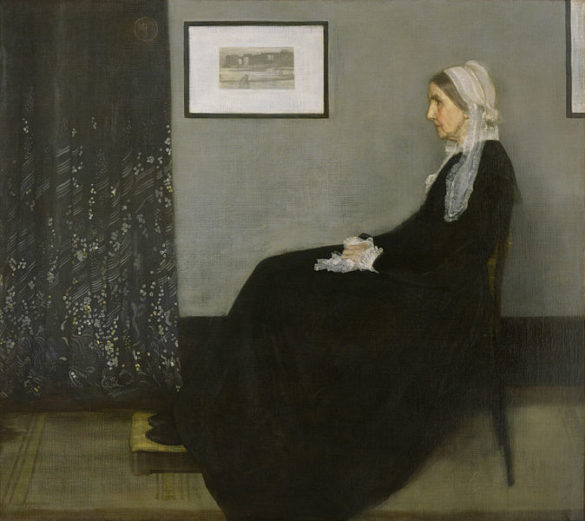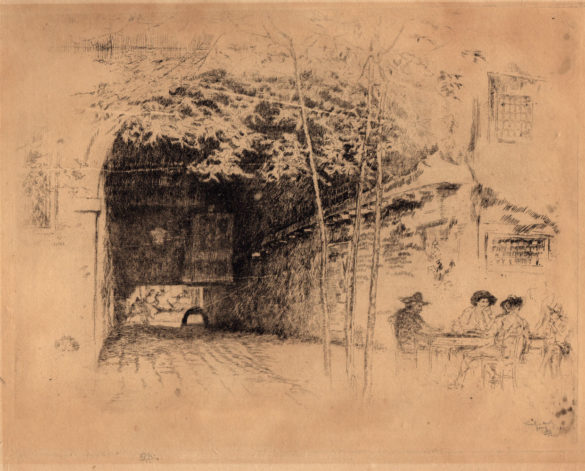WRITTEN BY CURATORIAL INTERN CHELSEA LOWERY CORNELIUS
James McNeill Whistler (1834 – 1903) was a complicated artist who approached his life and work in a unique, often unorthodox way. At the age of 11 he began studying fine art in Russia and realized art would be his profession. He would later tell people he was born in St. Petersburg, Russia as opposed to his actual birthplace of Lowell, Massachusetts. He approached life with a bohemian artist spirit which often meant relying on the generosity of wealthy friends and family, and learning from his peers such as poet Charles Baudelaire (1821 – 1864), who taught him principles of art he used throughout his career. Those principles included choosing to draw and paint as a realist, which often meant searching for the brutality of life and nature, as well as staying true to the idea that black is the fundamental color of tonal harmony and line is more important than color, an argument dating back to Florentine artists of the Renaissance.

James McNeill Whistler, ‘Arrangement in Grey and Black No. 1’ , 56 x 64 in., 1871, oil on canvas, Musée d’Osay
The supremacy of the line can be seen in Whistler’s most famous work, the portrait of his mother. The almost monochromatic painting is unique both in color and composition as his mother is captured in profile. The tonal harmony of the composition, and how the artist translates his mother’s pious nature with an impressive economy of means, met with great acclaim from both the academy and art historians.

Edward Linley Sambourne, ‘An Appeal to the Law’, Punch 1878, (image from ‘Turner Whistler Monet: Ruskin v Whistler’, https://www.tate.org.uk/whats-on/tate-britain/exhibition/turner-whistler-monet/who-what-when/ruskin-v-whistler)
However, praises were not a common thing when it came to Whistler. Following a modern aesthetic and style left him susceptible to a great deal of criticism from members of the Royal Academy of Art and contemporary scholars. In 1877, an exasperated Whistler sued art critic John Ruskin (1819 – 1900) for slander as Ruskin publicly attacked his art in a newspaper article. Whistler was hoping for a payday as he was falling into more debt, but although the case eventually ruled in his favor, he didn’t receive a windfall. Shortly after the trial he had to declare bankruptcy and see all of his possessions auctioned off at Sotheby’s. It was around this time that he received a commission from the Fine Arts Society of London to create 12 etchings of Venice, and he jumped at the chance for a fresh start.
Whistler arrived in Italy in September 1879 to complete his task and shared a palazzo with several artists, including John Singer Sargent (1856 – 1925). The initial three-month trip stretched to 14 months, during which time he produced over 100 pastels and 50 etchings, which became some of the most important works of his career. In an effort to break away from the usual monuments and tourist spots, he focused on hidden canals, alleyways, and courtyards that gave a glimpse into the daily lives of Venetians. He would travel all over the city with prepared copper plates in his pocket ready to capture anything that caught his eye. Aesthetically, he played with light and shadow, reflections of the water, and experimented with different types of paper.

By the time Whistler left Venice, legend of his sharp wit, provocative, and egocentric nature was spreading. Artists such as Frank Duveneck (1848 – 1919) and Robert Frederick Blum (1857 – 1903), who had sojourned in Venice, returned to America emulating Whistler’s vision and approach to printmaking. His followers were happy to be called “pupils of Whistler.”
You can see several works of Whistler and the artists he impacted in the late 19th and early 20th centuries in the exhibition An American in Venice: James McNeill Whistler and His Legacy until July 23, 2017. The show features prime examples of Whistler’s innovative technique and singular subject matters. Organized by the Syracuse University Art Collection.


